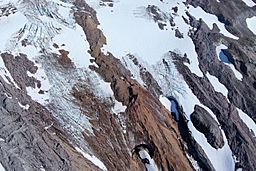Sandy Glacier Caves facts for kids
Quick facts for kids Sandy Glacier Caves |
|
|---|---|

An aerial view of the collapsed "Snow Dragon" and the nearby "Pure Imagination" ice caves taken August 29, 2016.
|
|
| Location | Clackamas County, Oregon, U.S. |
| Length | >1 mile |
| Geology | cavern in glacial ice |
| Difficulty | Difficult |
| Hazards | Exposure, hypothermia, structure collapse |
| Access | Public |
The Sandy Glacier Caves are amazing glacier caves found inside the ice of Sandy Glacier. This glacier is located on Mount Hood in Oregon. Many people believe these caves are the biggest glacier caves in the lower 48 states of the United States.
Explorers measured the caves in 2011 and 2012. They found the caves were over 1 mile long, which is about 7,000 feet! These caves formed when ice inside the glacier melted. This melting also creates the start of the Muddy Fork river. As the ice keeps melting, the caves get bigger. Their entrances slowly move up the glacier's side. Sadly, scientists think these caves might disappear completely in 7 to 10 years. This will happen when the melting inside reaches the surface of the glacier.
In early summer, three main caves inside the glacier connect. They are called the Snow Dragon Glacier Cave System. But by late summer, the ice connecting them melts away. Then, they become separate caves named Snow Dragon, Pure Imagination, and Frozen Minotaur Caves. In 2013, a fourth glacier cave was found on Sandy Glacier. However, it has not yet been explored.
Contents
Discovering the Caves
The Sandy Glacier Caves first caught the eye of Brent McGregor and Eddy Cartaya. They are both members of the Oregon High Desert Grotto, a group that explores caves. They saw a video on YouTube showing people at the entrance of a new glacier cave.
First Explorations
McGregor and Cartaya were not prepared at first. But they soon explored the cave with Scott Linn. After that, they returned to map the cave. They named it Snow Dragon. On other trips, they found Pure Imagination Cave and then Frozen Minotaur.
Mapping the System
In 2012, the Oregon High Desert Grotto and other members of the NSS mapped the whole cave system. By October 2013, McGregor and Cartaya had spent over 300 hours mapping more than a mile of caves.
Documenting the Caves
In 2013, after many visits, a TV show called OPB's Oregon Field Guide filmed the caves. This was their most complex filming project. They wanted to show the caves being studied by the grotto and scientists.
Recent Expeditions
Since 2014, McGregor's team, called the Glacier Cave Explorers, has gone on three trips to the glacier. They map the caves, take pictures, and collect information about the environment. They found surprising things inside the caves, like fir tree seedlings, duck feathers, and tiny living things called extremophiles. Extremophiles are organisms that can live in very harsh conditions. The team has also brought scientists with them, including glaciologists Andrew Fountain, Jason Gulley, and Gunnar Johnson. Glaciologists are scientists who study glaciers.
The Glacier's Story
The Sandy Glacier has lost a lot of its ice over time. Between 1907 and 2004, it lost about 40% of its ice. That's almost half!
Measuring Ice Loss
Expeditions led by Cartaya and McGregor included Andrew Fountain. He helped figure out how much ice the glacier was losing each year. They did this by placing stakes on the surface of the ice.
What Scientists Found
Inside Snow Dragon Cave, temperatures were measured at over 40 degrees Fahrenheit (about 4 degrees Celsius). Andrew Fountain believed the melting of the glacier meant it was "dying." He thought the caves would be completely gone in 5 to 10 years.
The Caves Disappear
In 2015, a large part of Snow Dragon Cave collapsed. The caves continued to collapse. By 2016, most of the caves were reported to be completely gone. At first, people thought climate change was the main reason for their disappearance. However, other things, like heat from inside the Earth (geothermal activity), also seemed to play a part.

